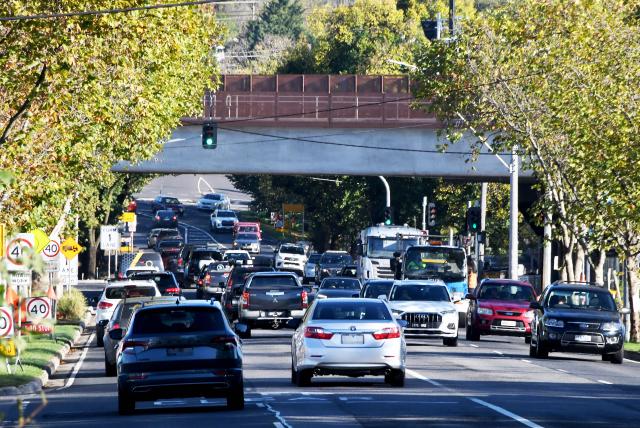
By Mikayla van Loon
The messaging for all the level crossing removal projects including Lilydale promoted the easing of congestion and removing dangers for drivers.
Since the opening of Maroondah Highway under the rail bridge, local residents say the reality of these promises have been relatively unchanged from when the boom gates were in place.
Resident of 24 years and worker for 10 years in Lilydale, Brendan McKenna has seen the traffic gradually get worse as housing estates have grown but he said while the boom gates did stop the flow of traffic, it was mostly the pedestrian lights that had the most effect.
“Between about 10 in the morning and about three or four in the afternoon the trains were every half hour, so there’s four movements an hour but the pedestrian crossing was going off all the time,” he said.
“I think there’s a lot of comparing apples and apples because on the Pakenham line they said the gate can be down for 10 or 15 minutes but that’s in the morning peak, you’ve also got the country train, the freight train, as well as the suburban.”
Mr McKenna said because the plan still included the pedestrian lights he knew there would not be much change to the traffic flow.
Another resident who has lived in Lilydale since the 1990s, Richard McLean said he would have liked to have seen a pedestrian overpass built into the design.
A government spokesperson said however, by adding station access from the eastern car park “passengers can catch the train without having to cross the Maroondah Highway during the morning and afternoon peaks.”
At the moment the lights seem to favour the pedestrian foot traffic rather than the cars, with Mr McKenna saying he timed how long cars had before the pedestrian lights changed.
“We actually timed that one day and I think it was about 25 or 30 seconds that traffic on the highway got a green light and it was about a minute that they were stopped for, so it was a third of the time,” he said.
The Department of Transport (DoT) has confirmed traffic engineers are still assessing the traffic volumes to find the right sequencing of the lights.
Mr McKenna said there seemed to be “almost a script they follow” and “every crossing is dangerous and congested” no matter how many accidents occur.
DoT data indicated there had been one collision and five near misses at both the Maroondah Highway and Manchester Road locations in the past 10 years.
“Removing the dangerous Maroondah Highway level crossing has significantly improved safety at the site for pedestrians and drivers, who were previously required to negotiate a five-lane bus interchange to enter Lilydale Station,” a government spokesperson said.
Yarra Ranges Highway Patrol senior constable Brett Truscott said when the boom gates were in place, drivers often toyed with beating the train.
“There’s always people who think their time is more important than their life and would do that kind of thing so it’s definitely a risk that has been mitigated by the overpass,” he said.
“From a safety point of view, it’s definitely worth it but as far as helping with the traffic flow, it probably hasn’t made a huge amount of difference.”
Mr McLean said as much as he loves what the new station looks like, for traffic and pedestrians it hasn’t been well designed.
“Raising it above was awesome. We all thought it was going to be great. And then they kept it a single lane,” he said.
“You can’t have a three lane highway, go the two lanes, go to one lane and then come into this brand new intersection where the actual light changes take twice as long.”
Mr McLean said when looking from the top of the highway towards Lilydale, a simple design feature could have been using the service lane outside Olex to provide an extra three lanes under the bridge while protecting the Queen’s Jubilee Avenue of Trees.
Mr McKenna also said diverting the traffic around the service lane outside Mitsubishi, similar to what they have done in the city where trees need to be protected, could have also been a solution to the traffic congestion.
“They forgot how to get people underneath that bridge in a more efficient manner and I think they’ve actually just stuffed up,” Mr McLean said.
Trying to avoid the congestion under the rail bridge, drivers have been using Beresford Road and John/Hardy Streets instead.
“There are people who are doing the rat race around Lilydale now going down Beresford Road,” Mr McLean said.
“People are taking risks in order to skirt around Lilydale. It’s becoming a bit more dangerous on Beresford road for kids trying to cross roads and elderly people as well.”
Senior constable Truscott said so far there hadn’t been an increase of collisions on any of the roads that can be used as detours.
While Mr McLean agrees the train station improvements to cater to more people using public transport were needed, he believes the other elements were left unresolved.
As more people move into the area with the Kinley development and as more people travel to the Yarra Valley, both Mr McLean and Mr McKenna said something will have to change to prevent accidents, particularly for people who don’t drive the road regularly.
“The two main boards were: one to stop fatalities and accidents, which if someone’s died in the last 100 years, that’s terrible. If someone’s been injured, that’s terrible as well. But the other one was to free up traffic and it has not gone anywhere, it’s just made it worse,” Mr McLean said
“There’s a bit of benefit with safety. Yes. But there’s not because the pedestrians still have to cross in front of the road. People are getting more frustrated so they’re taking shortcuts. [They] will just make mistakes because it doesn’t seem sensible.”






